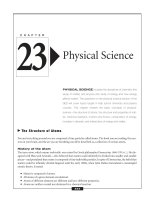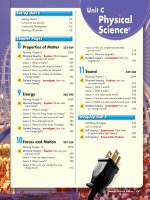Sound physical science
Bạn đang xem bản rút gọn của tài liệu. Xem và tải ngay bản đầy đủ của tài liệu tại đây (2.1 MB, 10 trang )
Physical Science
by Timothy Sandow
Genre
Nonfiction
Comprehension Skill
Compare and
Contrast
Text Features
•
•
•
•
Captions
Labels
Diagram
Glossary
Science Content
Sound
Scott Foresman Science 3.14
ISBN 0-328-13847-9
ì<(sk$m)=bdieha< +^-Ä-U-Ä-U
Vocabulary
What did you learn?
compression wave
1. How is sound made?
pitch
2. Describe the two ways stringed instruments
are played.
vibration
Sound
by Timothy Sandow
3. Explain how your ears help you hear.
Illustrations: 7, 14 Jeff Mangiat
Photographs: Every effort has been made to secure permission and provide appropriate credit for
photographic material. The publisher deeply regrets any omission and pledges to correct errors called to its
attention in subsequent editions. Unless otherwise acknowledged, all photographs are the property of Scott
Foresman, a division of Pearson Education. Photo locators denoted as follows: Top (T), Center (C), Bottom
(B), Left (L), Right (R) Background (Bkgd)
Opener: ©Jake Rajs/Getty Images; Title Page: ©DK Images; ©Lynn Stone/Index Stock Imagery; 2
©Joseph Sohm/ChromoSohm Inc./Corbis; 4 (CL, BR) ©DK Images; 5 Getty Images; 6 Getty Images,
8 Getty Images; 9 (CL, CC, BL) Getty Images; 11 ©Robert Brenner/PhotoEdit; 12 ©P. Freytag/Zefa/
Masterfile Corporation; 13 ©Scott Tysick/Masterfile Corporation; 15 (CL) ©Mark Tomalty/Masterfile
Corporation, (CC) ©Christiana Carvalho-Frank Lane Picture Agency/Corbis, (BR) ©DK Images, (BL)
Stone/Getty Images
ISBN: 0-328-13847-9
Copyright © Pearson Education, Inc.
All Rights Reserved. Printed in the United States of America. This publication is
protected by Copyright and permission should be obtained from the publisher prior
to any prohibited reproduction, storage in a retrieval system, or transmission in any
form by any means, electronic, mechanical, photocopying, recording, or likewise. For
information regarding permissions, write to: Permissions Department, Scott Foresman,
1900 East Lake Avenue, Glenview, Illinois 60025.
3 4 5 6 7 8 9 10 V010 13 12 11 10 09 08 07 06 05
4.
In this book you have read
about vocal cords and the pitch of your voice.
Write to explain how their relationship works.
Use details from the book.
5.
Compare and Contrast How do people
make sounds? How do animals make sounds?
Compare and contrast the ways people and
animals make sounds.
What causes sounds?
Take a walk in the city. Cities are noisy. Car horns
honk. Buses and garbage trucks roar by. People talk
Sounds are everywhere. Some sounds you hear
may hurt your ears. You may like other sounds. Each
sound you hear is different. Sounds are also alike in
some ways.
on the street. It is much quieter in the country. Birds
chirp. Cows moo. Water trickles in a creek.
Noisemakers are sometimes
used on New Year’s Eve.
Do you like the sounds they
make?
2
3
The Causes of Sound
Sound happens when matter moves back and forth
Hitting or Plucking to Make Sound
Some instruments make sounds when you hit them.
very quickly. This movement is called a vibration.
They are called percussion instruments. Drums are
There must be movement to make sound.
percussion instruments. Drums are played with rubber
The instruments pictured make sounds. They can
hammers, wooden sticks, brushes, or your hands. If
make high sounds. They can make low sounds. Pitch
you tap a drum lightly, you hear a soft sound. Hitting
is how high or low a sound is. Objects that vibrate
the drum harder makes a stronger vibration. This
slowly make a low-pitched sound. Objects that vibrate
makes a louder sound.
quickly make sounds that have a higher pitch.
You must hit or shake
a tambourine to make
a sound.
The blocks on this
instrument vibrate
when they are hit with
a rubber hammer.
These drums are different shapes
and sizes. Each one makes a
sound with a different pitch
when struck.
4
5
Stringed instruments are played in two ways. You
can pluck the strings. Or you can rub a bow across
Using Air to Make Sound
The sound of your voice is made by vibrations in
them. Both ways make sounds. The strings are
your windpipes. When air from your lungs passes
different sizes. They can be long or short and thick
between your vocal cords, they vibrate. You can speak
or thin. Some are stretched tighter than others. Long,
and sing because your vocal cords vibrate. When you
thick strings make a lower-pitched sound. Short,
speak, your cords tighten. The tighter they get, the
thin, tight strings make faster vibrations. They make
higher the pitch of your voice.
higher-pitched sounds.
Your vocal cords are
two pairs of thin tissue
in your windpipe.
Have you ever heard a
harp before? The strings
of this harp must be
plucked to vibrate.
6
7
A wind instrument’s sound comes from vibrating air
Some wind instruments use reeds. A reed is a thin
inside it. Blow into a trumpet. Your lips vibrate against
piece of wood. It is attached to the mouthpiece. When
the mouthpiece as you blow. This makes the air inside
a person blows on a reed, it vibrates. The vibration
the trumpet vibrate. It also makes sound.
makes the air inside the wind instrument vibrate.
You can change the pitch of the trumpet’s sound
The vibrating air makes a sound. If you press the keys
in two ways. Change how your lips vibrate. Or
of the wind instrument, you can change the pitch of
press on the valves of the trumpet. Pressing on the
the sound.
valves changes how long the air column is inside
the trumpet.
All three of these wind
instruments use reeds.
Clarinet
Saxophone
Do you know how to
play a trumpet?
Harmonica
8
9
Sound waves travel through matter. Some of the
How does sound travel?
particles that make up matter get squeezed. Other
What are sound waves?
particles are spread apart. The particles of matter take
A bell rings. Its vibrations move in the air. Some air
turns being squeezed and spread out. The length of a
particles are spread out. Others are squeezed together.
sound wave can be measured. We measure from the
The particles take turns doing this. This allows the
center of one squeezed area to the center of the next.
bell’s vibrations to move between these particles. This
movement makes a wave called a compression
wave. Sound waves are compression waves.
Sound travels as
waves in the air.
Wavelength
Sound waves from a jackhammer have lots
of energy. If you were standing nearby, you
would hear a very loud sound. Sound waves
lose energy as they move away. Farther
away, the sound would not be as loud.
10
11
Sound and Matter
You hear sound only when it travels through matter.
Echoes are sound waves that hit something and
bounce back. Scientists use sound waves and echoes
Sound can travel through solids, liquids, and gases.
to study the ocean. A ship sends out a sound wave.
The speed of a sound wave is different in each kind
When the sound wave hits the bottom of the ocean, it
of matter.
bounces back. Scientists measure how long the sound
The gases of air have particles that are far
apart. Sound travels slowly through gases. Liquid
wave takes to bounce back. Then they can figure out
how deep the ocean is at that spot.
particles are closer together. Sound travels more
quickly through a liquid than a gas. Solid particles
are closer together than gases or liquids. Sound travels
fastest through solids.
Sound travels at about
1,530 meters per second
in water. Some whales
can make sounds that
can be heard up to 160
kilometers away.
Speed of Sound
Material
Speed
(meters per second)
Solid—Steel
5,200
Liquid—Seawater
1,530
Gas—Air
340
Light travels faster than sound.
That is why you may see fireworks
before you hear them.
12
13
The Ear
Many animals have vocal cords like people do.
We hear sounds with our ears. The outer ear catches
They make sounds when their vocal cords vibrate.
sound waves. The waves travel inside the ear to the
Dogs bark. Cows moo. Some animals make sounds
eardrum. When the sound waves hit the eardrum,
that do not use vocal cords. Bees and mosquitoes
they make it vibrate. The vibrating eardrum makes
make buzzing sounds when their wings vibrate.
little bones vibrate. The little bones touch the shell-like
Bats send out sounds people cannot hear. The
inner ear. It is filled with liquid and tiny hairs. The
sounds are high-pitched and bounce off insects.
vibrating little bones make the tiny hairs move. The
The sounds return to the bats’ ears. This helps the
hairs are connected to nerves. The nerves carry signals
bats find their food.
to the brain. The brain recognizes the signals. Then we
know what we are hearing.
Many insects make sounds by
rubbing body parts together.
Little bones
Eardrum
Outer ear
Chimpanzees grunt,
bark, squeak, scream,
and even laugh.
Inner ear
14
Zebras make sounds
by vibrating their vocal
cords, lips, and nostrils.
15
Glossary
Vocabulary
What did you learn?
compressionwave
wave
compression
the wavelike movement of
pitch
particles squeezing together
vibration
and spreading out again
pitch
how high or low a sound is
vibration
the back-and-forth movement
of matter
Illustrations: 7, 14 Jeff Mangiat
Photographs: Every effort has been made to secure permission and provide appropriate credit for
photographic material. The publisher deeply regrets any omission and pledges to correct errors called to its
attention in subsequent editions. Unless otherwise acknowledged, all photographs are the property of Scott
Foresman, a division of Pearson Education. Photo locators denoted as follows: Top (T), Center (C), Bottom
(B), Left (L), Right (R) Background (Bkgd)
Opener: ©Jake Rajs/Getty Images; Title Page: ©DK Images; ©Lynn Stone/Index Stock Imagery; 2
©Joseph Sohm/ChromoSohm Inc./Corbis; 4 (CL, BR) ©DK Images; 5 Getty Images; 6 Getty Images,
8 Getty Images; 9 (CL, CC, BL) Getty Images; 11 ©Robert Brenner/PhotoEdit; 12 ©P. Freytag/Zefa/
Masterfile Corporation; 13 ©Scott Tysick/Masterfile Corporation; 15 (CL) ©Mark Tomalty/Masterfile
Corporation, (CC) ©Christiana Carvalho-Frank Lane Picture Agency/Corbis, (BR) ©DK Images, (BL)
Stone/Getty Images
ISBN: 0-328-13847-9
Copyright © Pearson Education, Inc.
All Rights Reserved. Printed in the United States of America. This publication is
protected by Copyright and permission should be obtained from the publisher prior
to any prohibited reproduction, storage in a retrieval system, or transmission in any
form by any means, electronic, mechanical, photocopying, recording, or likewise. For
information regarding permissions, write to: Permissions Department, Scott Foresman,
1900 East Lake Avenue, Glenview, Illinois 60025.
3 4 5 6 7 8 9 10 V010 13 12 11 10 09 08 07 06 05
16
1. How is sound made?
2. Describe the two ways stringed instruments
are played.
3. Explain how your ears help you hear.
4.
In this book you have read
about vocal cords and the pitch of your voice.
Write to explain how their relationship works.
Use details from the book.
5.
Compare and Contrast How do people
make sounds? How do animals make sounds?
Compare and contrast the ways people and
animals make sounds.









